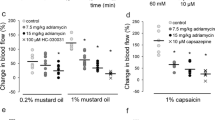Abstract
Perineural application of capsaicin results in a selective and permanent reduction in the sensitivity to noxious chemical and heat stimuli and elimination of the neurogenic inflammatory response. The present quantitative immunohistochemical study has been undertaken to reveal the populations of cutaneous afferent nerves that are affected by perineural capsaicin treatment. Areas of intact and chemodenervated skin were determined with the aid of the vascular labelling technique. In sections taken from intact skin areas, staining with antibodies against protein gene product 9.5 revealed a rich epidermal innervation. Fibres immunoreactive for growth-associated protein 43 were also abundant; nerve fibres immunoreactive for substance P and calcitonin gene-related peptide were less numerous. Somatostatin- and RT97-immunoreactive fibres were seen only in the subepidermal layer. In sections taken from skin areas supplied by the sciatic nerve treated with capsaicin 3 days previously, the number of epidermal nerve fibres immunoreactive to protein gene product 9.5, growth-associated protein 43, substance P and calcitonin gene-related peptide was reduced by 90%, 95%, 97% and 66%, respectively. These changes persisted for at least 42 days. The findings reveal that the majority of epidermal axons are capsaicin-sensitive and comprise a chemically heterogeneous population. Reductions in cutaneous fibre populations following perineural capsaicin treatment may result from both the degeneration of sensory axons and the depletion of neuron-specific macromolecules. In addition, most cutaneous nociceptive axons may not use the major sensory neuropeptides substance P and calcitonin gene-related peptide as afferent neurotransmitters.
Similar content being viewed by others
Author information
Authors and Affiliations
Additional information
Received: 11 February 1998 / Accepted: 21 December 1998
Rights and permissions
About this article
Cite this article
Dux, M., Sann, H., Schemann, M. et al. Changes in fibre populations of the rat hairy skin following selective chemodenervation by capsaicin. Cell Tissue Res 296, 471–477 (1999). https://doi.org/10.1007/s004410051307
Issue Date:
DOI: https://doi.org/10.1007/s004410051307




